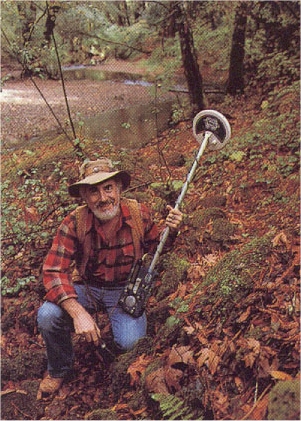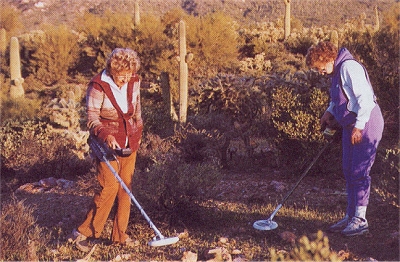By JIMMY SIERRA
In the metal detecting industry, there is a term which has recently been
misused a great deal. This term is:“discrimination.”
 Some have said that the pen is mightier than the sword, and I am sure that on occasions this has truly been the case. Throughout the ages, man has used words to explain, convince and cajole his fellows about one thing or another. Advertising executives are no exception to the rule; and in their deft hands, a word can become downright dangerous or at least costly to some of us. I am, of course, speaking about the use of the language without explaining the meaning of the terms used.
Some have said that the pen is mightier than the sword, and I am sure that on occasions this has truly been the case. Throughout the ages, man has used words to explain, convince and cajole his fellows about one thing or another. Advertising executives are no exception to the rule; and in their deft hands, a word can become downright dangerous or at least costly to some of us. I am, of course, speaking about the use of the language without explaining the meaning of the terms used.
Every special interest has built into it numerous buzz words. Golfers, tennis fans and fishermen all have special terms familiar to the insider, and metal detector users are no exception. We all get to know these terms as we read articles and talk with the cadre of users. However, there is one term which had been used correctly for a long time, but which has more-recently been misused a great deal. This term is “discrimination.”
Discrimination was originally conceived by metal detector engineers as a means of operating a detector in junky areas; and, by some electronic magic, eliminate or alter the sound of a target which consists of unwanted material and thus increase the amount of good targets for the treasure hunter. This whole experiment was intended to benefit the coin hunters, who were in fact the majority of treasure hunters. When I first started detecting, metal detectors had no such ability and we dug everything. We found a lot of good items, of course; but spent a lot of time doing it. Then along came ground-cancelling, which is a form of discrimination; and our detectors starting detecting deeper and deeper. Along with the added depth came the attraction of these new GEB or VLF units for nails. Not to be outsmarted, the electronic engineers came out with a discriminator for iron trash, then one for other junk items such as pull tabs and foil.
All of these so-called discriminators worked in the same way, by eliminating or altering the sound of an undesirable target. All had the same weakness: The more mineralized the ground, the less they were able to penetrate compared to the al- metal or non-discriminate mode of the detector. Even with the so-called motion discriminator, this still holds true. A GEB or VLF discriminator goes deeper than the old TR discriminators, but not as deep as the all-metal mode when there is increased mineralization in the ground that you are searching.
 But with the advent of meter identification on many detectors, the user was no-longer locked into searching in a discriminate mode with limited depth. He or she could finally search in an all-metal mode if desired and check the meter for probability of target identification. This is where the definition of terms is becoming important and what I have been leading up to. I have recently heard it said that this or that detector is better for prospecting because it doesn’t discriminate, and many a treasure hunter has set aside his or her perfectly good multipurpose unit and bought another unit just for prospecting. I am not suggesting that these new units are not worthy of the task; but in many instances, it was costly and unnecessary to buy two units. First of all, the original unit should be able to cancel the ground effectively; and secondly, the owner must learn the skills necessary to operate it in a prospecting environment. Every company makes such units, and all are capable of finding the elusive gold nugget. The meter should work independently of the all-metal audio signal. That is, you should be able to operate the detector in the all-metal mode and hear every target that the loop passes over. The meter should respond to these targets in some sort of predictable fashion.
But with the advent of meter identification on many detectors, the user was no-longer locked into searching in a discriminate mode with limited depth. He or she could finally search in an all-metal mode if desired and check the meter for probability of target identification. This is where the definition of terms is becoming important and what I have been leading up to. I have recently heard it said that this or that detector is better for prospecting because it doesn’t discriminate, and many a treasure hunter has set aside his or her perfectly good multipurpose unit and bought another unit just for prospecting. I am not suggesting that these new units are not worthy of the task; but in many instances, it was costly and unnecessary to buy two units. First of all, the original unit should be able to cancel the ground effectively; and secondly, the owner must learn the skills necessary to operate it in a prospecting environment. Every company makes such units, and all are capable of finding the elusive gold nugget. The meter should work independently of the all-metal audio signal. That is, you should be able to operate the detector in the all-metal mode and hear every target that the loop passes over. The meter should respond to these targets in some sort of predictable fashion.
Thus the meter really ceases to be a discriminator, but functions in reality as a target analyzer. This is the term I feel is more appropriate. Even though this is visual discrimination, nothing is being eliminated as is the inference when the term “discriminate” is used. Of course, there are limitations to this ability, namely the extent of the mineralization in the ground. The meter is, of course, still working in the discriminate circuit of the detector and has depth capability depending upon the amount of ground mineralization. But it is there when you can use it, and it is a valuable tool indeed.
On a recent trip into the El Paso mountains in southern California with my White’s Eagle, I spent the better part of three days fighting the intense heat and struggling with the enormous amount of metal trash in an old mining area. The two fellows prospecting with me were digging all targets and collected between them enough nails to build a small shed. In about the same period of time and number of targets later, I had accumulated only a hand full of nails, but enough lead and brass for a small arsenal. My point is, there are only so many targets a day a human body can dig. The more probable gold nuggets there are (lead, copper and brass are all probable nuggets), the more gold will be dug. The more nails and iron trash you must dig up, the less the odds of digging a nugget. It is an odds-game from the start. I ended up with a single 2.7 pennyweight. nugget on the third day, not from skill, but from better odds and some luck.
One of my good friends has used a Whites 6000Di/pro during the past two years, gleaning gold nuggets from the tailings and gullies of north-central California. The area he works was heavily populated with miners, and the iron trash is extensive. He works with a smaller loop to get in-between the trash, and has told me he never digs a target unless his meter indicates the possibility of a desirable target.
On the other hand, you must always consider that tiny nuggets can drop into the iron range (meter reading), and thus I do recommend digging any dubious signal. When in doubt…DIG.
Just so you don’t think all is peaches and cream, there is a minus side to every method. Because of the extreme mineralization in some locations, there will be times when you will not be able to rely upon your meter or display screen. You will know this because your meter will respond to the ground with readings or numbers whether or not a target is there at all. At these times, you will have to dig all targets just as if you didn’t have a target analyzer meter at all.
I learned this the hard way a while back on a trip into the Pinto Mountains near 29 Palms. A group of us with an assortment of units started out early one morning and headed about two hours into the desert for a dry-wash known to produce nuggets. I headed down the wash with my trusty Eagle in tow which had just come from a successful trip to the Sierra’s where my meter ID worked beautifully. In fact, a ¼-grain nugget had registered with a positive dig signal on the eighth or ninth pass. I was a bit cocky, and I broke my cardinal rule: Put down a nugget or two of varying sizes and cover them with some of the local terra firma. Check the sound and the meter to see the response. In other words, know what you are getting into. My friend of the El Pasos came down the gully behind me. I stopped at a number of signals, checked the meter and walked on. A few moments later, my friend beckoned me back. “Check this one,” he said. I did, and it sounded good. But the meter said iron. It was a small nugget of a few grains. I checked my sample nuggets and got the same response. In fact, I had to progress to a half-pennyweight nugget before the reading would not be overridden by the heavy ground mineralization! The gully was full, as should be expected, with much black sand; and it was overriding the nugget response on the meter. The sound was loud and clear, but the meter reading was unreliable. This was one of those instances where you dig everything if you want small targets, or you just settle for the less-frequent larger nugget.
The incessant hot rock can also be easily identified with a meter and not be the bother that some make of it. All this takes skill and practice. Learn to use your detector, whichever one you buy.
Remember, you have to be standing over a nugget to find it!





